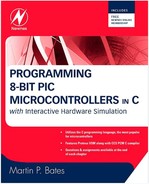Assessment 5
5 points each unless otherwise stated, total 100
1. Explain why hysteresis is useful in processing switched inputs.
2. Write two C statements that select analog input AN1 and read it, and explain briefly why the variable comes first in the read statement but is given as the function argument in the select statement.
3. Draw a block diagram of a simple temperature control system, consisting of a temperature sensor, heater, fan, start and stop buttons, and status indicators for “running” and “temperature OK.” (10 points)
4. Write a basic program outline for the system described in Question 3 which has a single fixed operating temperature and no hysteresis. A polling loop will wait for the start button to be operated, while the stop button will shut down the system via the MCU reset input.
5. Explain briefly why analog inputs, serial flash ROM, and a serial data link are useful features of data logging system hardware.
6. Explain briefly how the use of a timer interrupt allows an accurate data logging interval to be more easily implemented than simple input polling.
7. Explain briefly the meaning of interrupt priority.
8. Compare briefly the different features of a standard PC operating system and an RTOS.
9. Explain briefly the significance of each part of the CCS C RTOS task definition directive #task(rate=500 ms,max=100 ms).
10. Explain briefly the main difference between a microprocessor and microcontroller-based hardware system.
11. Explain briefly the main advantage of a SoC when compared to a conventional microcontroller.
12. State five criteria for selecting a microcontroller type or family.
13. State five criteria for selecting a microcontroller for a given application.
14. Explain briefly why the cost of a microcontroller application prototype is relatively high, but the cost per unit reduces as more systems are produced using that design, and sketch a curve that illustrates this fact.
15. Compare briefly the merits of a serial alphanumeric LCD module and the DMM display used in the PICDEM mechatronics board.
16. Discuss briefly the factors that affect power consumption in an embedded system and how to evaluate it.
17. Explain the advantages of using C for embedded applications. (10 points)
